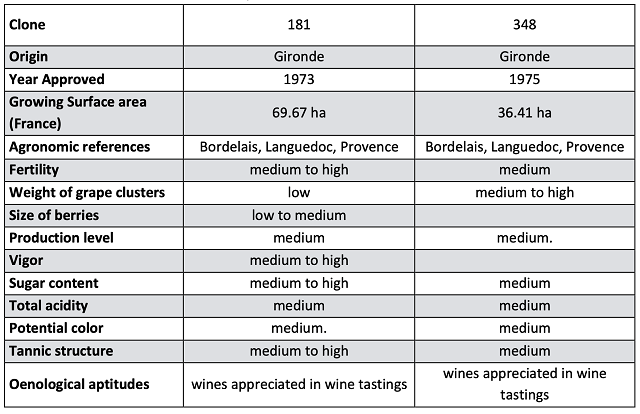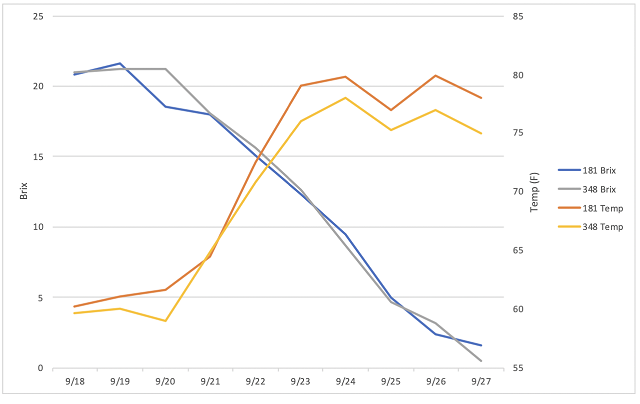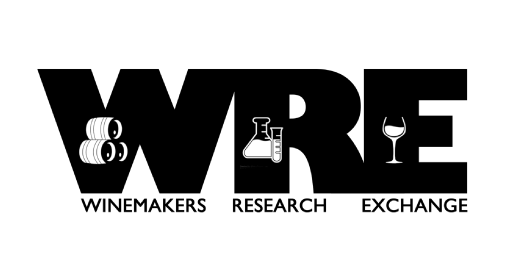Comparison of Wine Quality from Two Clones of Merlot
Nate Walsh and Ben Sedlins
Walsh Family Wine
Summary
Side by side studies comparing different clones of Merlot in other regions have shown differences in vegetative growth, yield, berries per cluster, berry weight, and cluster weights among clones, as well as differences in pH and potassium of resulting juice. The purpose of this study was to examine performance of two clones of Merlot, 348 and 181, in Virginia. Clone 181 produced heavier clusters with slightly higher Brix at harvest. Finished wine parameters were very much the same between clones and there were no significant differences in sensory scores for aromatic intensity, color, fruit intensity, or astringency/structure.
Introduction
Merlot first appeared as a named variety in French literature at the end of the 18th century, and was imported to the US in the 19th century1. The variety gained wide popularity in France in the 1970’s, and by 2006 it was the top planted black grape in France. Though it was initially used primarily for blending in California, its popularity in France was mirrored on the West Coast of the US with heavy planting in California, Washington State, and Oregon. East Coast viticulture also adopted the variety with plantings in New York and Virginia1. Merlot now makes up 10% of the Vitis vinifera planted in the world1.
In Virginia, Merlot makes up 15% of reported Vinifera tonnage and 14% of bearing acres, the second highest red variety after Cabernet Franc2. Merlot is often the first red to ripen, and is used for blending, as a varietal wine, and for Rose. It is sensitive to cold injury, susceptible to nonspecific bunch rots, and can have poor fruit set if weather is cool during bloom3. When managed well in the vineyard, it has the potential to produce high quality red wine.
Within the variety, there are several known clones of Merlot. UC Davis’s Foundation plant services website, which catalogues varieties and clones that have been cultivated and certified through grapevine breeding program, list 33 different clones for Cab Franc4 and there are 12 clones characterized on the ENTAV website5. A clone (also known as a cultivar) is a single genetic expression, created by propagation from a single mother vine that was carefully selected for specific traits such as cold hardiness, disease resistance, or quality of juice 6. In modern times, cuttings from a single vine are grafted to rootstock, which may further impact the genetic expression of the clone.
Side by side studies comparing different clones of Merlot7,8 have shown differences in vegetative growth, yield, berries per cluster, berry weight, and cluster weights among clones, as well as differences in pH and potassium of resulting juice. One study conducted in Serbia compared several clones, 348 and 181 among them. They found that clone 181 had higher yield, grapes per vine, and larger berries, but some of these differences were not significant8. Vintage differences also play a significant role in these metrics8,9.
Though clones are usually characterized at their place of origin, they may behave differently in different climates and when grafted to different rootstocks. The purpose of this study was to examine performance of two clones of Merlot, 348 and 181, in Virginia. Characteristics of each clone from the ENTAV database are listed in Table 1.
Table 1: Comparison of Clones 181 and 34810

Methods
The experiment was conducted at Walsh Family Vineyard, near Leesburg, Virginia, in a 1.64 acre block of Merlot. The vineyard block was established in 2016. The Merlot was planted to clones 181 and 348 on 101-14 rootstock. The vineyard design is 7.5 ft by 3.75 ft spacing on a VSP trellis, and the vines are trained to a unilateral cordon. The site is situated at 570 to 640-ft above sea level, on a 10-15° slope oriented east, northeast. The Merlot is mapped by geovine.com as the Myersville-Catoctin complex.
Grapes from each clone were harvested separately on the same day and wine was made with identical winemaking according to the standard protocols of the winery. Fruit was destemmed with the addition of 30 ppm SO2. A 17% bleed by weight was conducted prior to cold soak. Fruit was cold soaked for 24 hours, covered with dry ice. Bins were warmed, then fermentation was inoculated with 20 g/hL BDX yeast. Tartaric acid (1 g/hL) was added at the end of cold soak. Fermentation was monitored daily for Brix and temperature with a target temperature around 80°F. Bins were pumped over twice daily during cold soak and for the first three days of fermentation, after which they received two punchdowns daily. Fermaid K (12 g/hL) was added at the end of lag phase.
Malolactic fermentation was inoculated at 5°Brix using 1 g/hL MBR31. Bins were drained/pressed on the same day after extended maceration of 10 days. The cap fell after 7 days. Bins were punched down until the cap fell, then gassed and sealed until pressing. Both bins received the same number of days total from picking to pressing. Wine was monitored for malic acid depletion using paper chromatography. Sulfur dioxide (50 ppm) was added at the completion of ML. An additional 50 ppm was added after 30 days.
Sensory analysis was completed by a panel of 26 wine producers. Wines were presented blind in randomly numbered glasses. Tasters were presented with three wines, two of one type and one of another, and asked to identify which wine was different (a triangle test). There were three tasting groups with the unique wine in the triangle test balanced between groups. Tasters were then asked to score each wine on a scale of 0 to 10 for aromatic intensity, color, fruit intensity, and structure (astringency). They were also given open ended questions to describe the wines. Results for the triangle test were analyzed using a one-tailed Z test. Descriptive scores were analyzed using repeated measures ANOVA.
Results
Clone 348 produced notably heavier clusters (Table 2). Fruit from Clone 181 was harvested with higher Brix than Clone 348, but with similar pH and TA (Table 3). Fermentation was robust for fruit from both clones (Figure 1). Both clones produced wine with very similar general chemistry (Table 4). Clone 181 produced wine with higher color intensity, with no difference in hue (Table 5). Anthocyanins were also not notably different between clones (Table 6), nor was there a perceptible difference in color (Table 8). Color is complex, with influences from anthocyanins as well as wine pH and cofactors. Phenolic measurements were very similar between wines, though Clone 181 had somewhat higher tannin (Table 7). The two wines did not have differences in perceived structure (astringency)(Table 8). In a triangle test of wines made from two different clones of Merlot, 13 out of 26 respondents were able to distinguish which wine was different, indicating the wines were nearly significantly different (Z= 1.595, p= 0.055). However, there were no significant differences in scores for aromatic intensity, color, fruit intensity, and structure (astringency) (Table 8). Several tasters noted in open ended comments that the wines were very similar.
Figure 1: Fermentation kinetics of two clones of Merlot (in-house data)

Table 2: Fruit metrics for two clones of Merlot (in-house data)

Table 3: Juice chemistry for two clones of Merlot (in-house data)

Table 4: Wine chemistry for two clones of Merlot (ICV Labs)

Table 5: Color metrics for two clones of Merlot (ICV Labs)

Table 6: Anthocyanins for two clones of Merlot (mg/L)(ETS Labs)

Table 7: Phenolics for two clones of Merlot (mg/L)(ETS Labs)

Table 8: Descriptive scores for two clones of Merlot (WRE)

References
(1) Sweet, N. Black Grapes of Bordeaux. Wine Grapes of UC Davis, 2018.
(2) SMS Research Advisors. 2019 Virginia Commercial Grape Report. 2020.
(3) Wolf, T. K. Wine Grape Production Guide for Eastern North America; Plant and Life Sciences Publishing: Ithaca, New York, 2008.
(4) Grape Variety: Cabernet Franc. Foundation Plant Services Grapes.
(5) Cabernet Franc N. Pl@nt Grape: Catalogue of grapevines in France.
(6) Wilcox, K. Winemakers Still Fighting the Clone Wars. Wine Searcher. September 12, 2020.
(7) Benkwitz, F.; Tominaga, T.; Kilmartin, P. A.; Lund, C.; Wohlers, M.; Nicolau, L. Identifying the Chemical Composition Related to the Distinct Aroma Characteristics of New Zealand Sauvignon Blanc Wines. American Journal of Enology and Viticulture 2012, 63 (1), 62–72. https://doi.org/10.5344/ajev.2011.10074.
(8) Sivcev, B.; Rankovic-Vasix, Z.; Petrovic, A.; Jancic, R.; Milisic, K. Fruit Characteristics of the Merlot Clones in Belgrade Wine Growing Region, Serbia. Journal of Advancements in Plant Science 2018, 1 (2), 1–4.
(9) Benz, M. J.; Anderson, M. M.; Williams, M. A.; Barnhisel, K.; Wolpert, J. A. Viticultural Performance of Five Merlot Clones in Oakville, Napa Valley. 2006, 5.
(10) Merlot N. Pl@nt Grap: Catalogue of grapevines in France.
